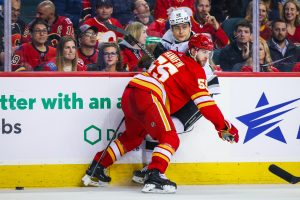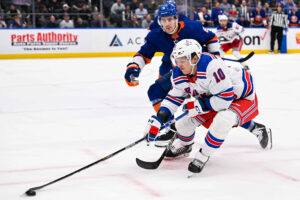Player development seems to always result in more questions than answers. How likely is it for a top pick to pan out? What makes a player a “steal”? Last Word On Hockey will be starting a new series on how to properly develop prospects from all different spots throughout the draft. This week’s piece involves top-10 picks and how they were used early in their careers.
Player Developments of Top 10 Picks
In the span of 2005 through 2015, there were 40 total selections made between fourth overall and tenth overall on forwards playing in North America. Of those 40 selections, one player was deemed near NHL-ready after one additional year in juniors and two AHL seasons. That player was Benoit Pouliot.
Player Development of Benoit Pouliot
Pouliot is an interesting case. Drafted fourth overall by the Minnesota Wild in the 2005 NHL draft, Pouliot never truly produced up to a top-10 pick standard. In his DY-1 season, Pouliot scored two goals and two assists in four games with the Sudbury Wolves in the OHL, as he spent the majority of that season in the CJHL. That was good for a 1.0 point-per-game pace, ranking 16th out of the aforementioned 40 forwards in DY-1 production. He followed that up with 29 goals and 38 assists for 67 points in 67 games with the Wolves in his draft year. That was again good for a 1.0 point-per-game pace, ranking 33rd of those 40 forwards in DY production.
Playing once again in juniors, with the Wolves, Pouliot would record 35 goals and 30 assists for 65 points in 51 games. That would garner a point-per-game pace of 1.275, ranking 22nd out of 28 forwards in DY+1 production. Those 28 forwards are all players who were not on NHL rosters in their DY+1 seasons. In 2006-07, Pouliot would play for the Houston Aeros, the Wild affiliates at the time. In 67 games, he would score 19 goals and 17 assists for 36 points. That was a 0.537 point-per-game pace, ranking 11th out of 12 forwards in DY+2 production. Those 12 forwards were the only forwards still not on an NHL roster in their respective DY+2 seasons.
One More AHL Season
In his DY+3 season, Pouliot would once again play in the AHL. Playing 46 games, he recorded 10 goals and 14 assists for 24 points. That’s a point-per-game pace of 0.522, ranking last among five forwards yet to make an NHL roster in their DY+3 seasons. After not posting great numbers, why was Pouliot considered close to NHL-ready? Because he was playing in the AHL longer than the other five forwards in their respective DY+3 seasons, leading to his production being comparatively worse despite playing in a tougher league.
Also, to this point, Pouliot had drawn into 14 NHL games over two seasons. However, my research only counts a player being on an NHL roster once they play 15 NHL games in a single season.
Pouliot’s Player Development
Finally, after a long time coming, 22-year-old Pouliot would play 37 NHL games and 30 AHL games. He recorded nine goals and 15 assists for 24 points in the AHL. In his rookie NHL season, Pouliot would score five goals and six assists for 11 points. Pouliot did that while averaging 11:51 time on ice per game. Analytically, Pouliot was not great at even-strength, posting a 0.9 EVO and -0.3 EVD. Essentially, he was a replacement-level player at five-on-five. Overall, Pouliot scored a -0.1 WAR and -0.7 GAR, essentially being a negative-impact player as a rookie.
Despite those struggles as a rookie, Pouliot would see 53 NHL games to just three AHL games, and average 15:28 time on ice per game. Pouliot would be traded after 14 games with his original team, heading to the Montreal Canadiens for 39 games there. In his 14 games with Minnesota, he would average 11:56 time on ice per game, essentially not seeing a raise. He went on to record two goals and four points there. But in Montreal, he averaged 16:44, a massive increase. That would lead to 15 goals and nine assists for 24 points. Analytically, between both teams, his EVO improved to 4.4, while his EVD dropped to -1.7. His overall impact also grew exponentially, with a 0.4 WAR and 2.8 GAR.
New Team, Same Story For Player Development
Unfortunately, despite having success with the Canadiens, they would not show that same confidence in Pouliot that they initially showed. He would play 79 NHL games, but his role would regress back down to averaging 11:32 time on ice per game. With that, Pouliot scored an impressive 13 goals and 17 assists for 30 points. He improved across the board for his analytics, with his EVO score at 5.6, and his EVD score at 1.2. Overall, his WAR landed at 0.9 and his GAR landed at 4.9.
Pouliot would leave Montreal after this season, likely due to wanting a bigger role. He would go on to play for five teams over seven seasons before retiring. Pouliot never reached his presumed ceiling after being taken fourth overall.
What Happened After Those Three Seasons?
As stated, Pouliot would leave the Canadiens after his third NHL season. He would join the Boston Bruins, playing 74 games with 32 points, averaging just 12:13 time on ice. Still not happy with his small role, he would once again leave in the offseason, joining the Tampa Bay Lightning in the lock-out shortened 2012-13 season. In 34 games, Pouliot scored 20 points. He would average 13:14 per game, a slight raise. But again, it seemingly wasn’t enough for Pouliot, leaving once again, this time joining the Edmonton Oilers.
He would remain with Edmonton for three seasons, playing 180 games, scoring 84 points, and averaging a solid 15:29 per season. In his final season with the Oilers, he would score just 14 points in 67 games, while averaging a new low with Edmonton; 14:03 time on ice per game. He would leave and join the Buffalo Sabres for one last NHL season, scoring 13 goals and 19 points through 74 games, averaging 13:41 per game. The player development for Pouliot was not great once he entered the NHL. However, it’s clear Pouliot simply never truly took that next step to break through, as evidenced by his long wait to reach the NHL full-time.
If Pouliot Never Took That Next Step, Was He The Wrong Pick?
Pouliot simply wasn’t worth the fourth overall selection. However, the 2005 NHL draft wasn’t exactly a strong one, in hindsight. The next five forwards selected in that class were Gilbert Brule, Jack Skille, Devin Setoguchi, Brian Lee, and Luc Bourdon. Pouliot would actually play more NHL games than all of them. However, Anze Kopitar was available, taken 11th overall by the Los Angeles Kings, and Carey Price was selected with the very next pick by the Canadiens.
Minnesota’s goalies in 2005-06 were Manny Fernandez (31 years old at the time), Dwayne Roloson (36) and Josh Harding (21). Harding was taken in the second round of the 2002 NHL draft by the Wild, so there was a belief that he was the future starter, but Price was a world-class goaltender then, and he still is today. Take that as you will, but selecting Pouliot over Price has surely haunted Minnesota for a long time.
*EVO: Even-Strength Offense Goals Above Replacement
*EVD: Even-Strength Defense Goals Above Replacement
*WAR: Wins Above Replacement
*GAR: Goals Above Replacement
Junior league stats via Elite Prospects, NHL stats via Hockey Reference, NHL analytics via Evolving Hockey






